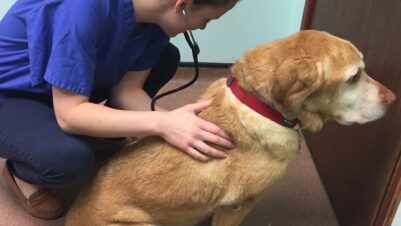
With rescue centres at a crisis point as people relinquish their “pandemic pups” and the cost of living rises, there has never been a more important time to educate and support your puppy owners, with the aim of providing early interventions and preventing future problems.
Though puppy owners are never short of advice – from friends, family, fellow dog walkers, Google and the hive mind of social media – your vet practice is where they are guaranteed to come face to face with qualified professionals. And this is where we want them to turn when they need help. Many young dogs will have more issues with behaviour and training than health, so it makes sense for the veterinary team to offer owners support by providing first-aid behavioural advice or signposting clients to accredited trainers and behaviourists when necessary.
There are lots of opportunities in the first 12 months of a puppy’s life for the veterinary team to educate and support owners. Much of this can be nurse-led, and if you have a veterinary nurse with extra qualifications in behaviour and a passion for the subject, then this is ideal. Many experienced nurses can give basic advice on training and behavioural issues, but if there is no one in your practice confident enough to do so, you can suggest that the client seeks help. For example, suggest they join a reputable puppy class with an accredited trainer or refer them to a qualified behaviourist.
Many young dogs will have more issues with behaviour and training than health, so it makes sense for the veterinary team to offer owners support by providing first-aid behavioural advice
By identifying that the client needs help and signposting them to the most appropriate help available, you provide support even if you can’t give the advice yourself. This support could make all the difference for some owners who may be at breaking point, don’t know where to turn and are considering rehoming.
Vaccination visits
The first time a puppy visits the practice will often be for their first or second vaccination. If this is the start of a two- or three-part course, it is useful to have a protocol in place stating what advice the practitioner should cover in each appointment. This allows the practitioner to provide as much information as possible without overwhelming the client.
The following example is based on three visits with a DHP and L4 protocol. However, the author encourages you to develop a protocol that works for your practice, incorporating the areas your clinical staff feel confident discussing.
First vaccination
Conversations during the first vaccination involve a full health check and are health-focused, covering owner concerns, diet and parasite prevention.
It is a good opportunity to educate owners about the importance of socialisation in the critical period (up to 12 weeks of age) while you are discussing when the puppy will be able to go out walking. Though puppies may be unable to go out for walks, it is imperative they are introduced (carried by owners) to the world for short periods or taken on trips in the car to observe new places. Doing so allows them to see, smell and hear the various stimuli they will encounter when they start walking.
Though puppies may be unable to go out for walks, it is imperative they are introduced (carried by owners) to the world for short periods or taken on trips in the car to observe new places
Let the client know that the puppy is due for another vaccine in a couple of weeks and that any concerns can be discussed during this visit, including behaviour. This gives owners time to think of things they want to ask rather than being put on the spot at the second vaccination appointment.
Second DHP
Two weeks after the first injection, check the puppy’s weight and ask if the owner has any concerns, specifically considering socialisation, housetraining and if the puppy is sleeping through the night. Has the owner started to get the puppy used to being alone for short periods? If they are having problems in these areas, then gently suggest they can become serious issues and that seeking help from a trainer or behaviourist could be hugely beneficial in this early stage.
The puppy will be able to start walking in a week, so you should suggest getting them used to a collar and lead before leaving the house – it’s one less thing for the puppy to learn when walks start. It is a good idea to check out the accredited trainers in your area and compile a list to give to your clients, pointing out that classes are a great way to socialise their pup and teach life skills.
Second L4
Check on the issues raised previously. Are the owners managing these or do they need extra help? How are walks going? At this stage, puppies have usually settled in and gained confidence, so their behaviour may start to become more challenging.
Weigh and worm checks
Monthly “weigh and worm checks” with nurses are a fantastic way to provide ongoing support to owners and bond them to the practice. They give clients an opportunity to raise concerns, which you can prompt by asking open questions relating to their puppy’s development stage. For example, asking “How’s teething going?” may instigate a conversation about mouthing and chewing.
These appointments are also an opportunity to desensitise puppies to fear-free handling. When giving them a quick health check, you can demonstrate and explain to owners how to get the puppy used to having their mouth opened, ears checked, feet held, etc. These visits must be positive experiences for the puppy, with lots of food rewards to help them form a positive association with the practice and staff.
Adolescent checks
Many owners experience challenging behaviour from dogs during adolescence, so offering adolescent health checks with a vet or a nurse is a good way to offer support to clients if required. These checks provide the opportunity to educate clients on physiological changes during adolescence and what behavioural changes they may see in their dog as a result – if owners know what to expect, then they can be prepared with the knowledge that this developmental period will pass.
Many owners experience challenging behaviour from dogs during adolescence, so offering adolescent health checks with a vet or a nurse is a good way to offer support
Owners should also be encouraged to remain consistent in their training, as many presume their dog is no longer responding to them and give up. Many dogs are relinquished to rescue during adolescence, so it can be a crucial time to refer clients to trainers or behaviourists.
Neuter clinics
Thankfully, many practices are moving away from the blanket “neuter at six months” policy and taking a more individual approach. All owners considering neutering should have an appointment with a vet or nurse to discuss the pros and cons of neutering, both from a health and behavioural point of view.
During these consultations, practitioners commonly discover that the client’s reason for neutering is the hope that it will improve their dog’s behaviour. “We are hoping it will calm him down” is a phrase I have heard a lot; however, we now know that castration, in particular, can have a negative impact on behaviour and is not recommended as a way to manage all behaviour problems. These clients should seek advice from an accredited behaviourist. If clients are reluctant to be referred to a behaviourist, then chemical castration is an option, allowing veterinary professionals to test how neutering will affect the dog before permanent surgery.
Puppy classes
Running puppy classes can be hugely beneficial for your clients and the practice; however, they need to be done properly. The traditional free-for-all puppy parties are often inadequate and can be overwhelming for puppies, which can have a negative rather than positive effect on them emotionally.
In an ideal world, every practice would have a clinical team member with behavioural qualifications or accreditation and the appropriate space to run their own educational puppy classes. Having run these myself, I assure you that, when run properly, they are incredibly popular and it is undeniable that they positively influence a dog’s experience of the veterinary environment. Many clients who attend bond to the practice for life, and the dogs will love coming to visit!
The traditional free-for-all puppy parties are often inadequate and can be overwhelming for puppies, which can have a negative rather than positive effect on them emotionally
Classes may be practically impossible for smaller practices, but you could offer puppy education evenings that cover the basics and give clients the opportunity to ask questions. If you have the space but no staff are appropriately qualified, consider working with a local trainer who could run classes in the practice for you. If neither of these are an option, then you could compile a list of trusted registered trainers/behaviourists and give all your puppy owners a copy.
Summary
During the first 12 months of a puppy’s life, the veterinary practice has the potential to offer many face-to-face appointments, which can be used to provide lots of health and behavioural support to owners. Regular support can help puppy owners experiencing behavioural challenges early by providing first-aid behavioural advice or referrals to accredited trainers/behaviourists when necessary.
Having a team member with additional qualifications or accreditation in behaviour is ideal, but you can also offer support through external referrals. Regular puppy clinics provide desensitisation and positive experiences for visiting dogs and can bond clients to the practice for life.







